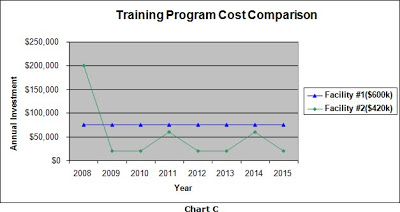December 30, 2008

Training Programs and Return on Investment
Industry:
Solution:

Costs of a Convergence Training Program and Your Current Training Program
To calculate the potential ROI of a new Convergence training program, you'll need to determine the costs of both the Convergence program and your current training program. Determining the cost of your current program is important because the cost savings between a Convergence program and your current program is one part of the benefit of the Convergence program (but not all of the benefit). Some costs of a training program are easy to identify. For example, if your company currently pays a consultant to create a training program, that's part of the program's cost. Alternately, if Convergence created a training program for your company, your payment for that program would be part of the cost. But many companies significantly underestimate the costs of their current training program. For example, they may think their costs are no greater than the fees paid to a consultant to create their program. But this neglects many other costs that should be assigned to the training program as well: the salary paid to supervisors who deliver the program; the wages—including possible overtime wages—paid to operators who take the training; administrative costs to track and report on the training as well as to create records of training; facility and/or equipment rental; the expense to create documents, and more. These expenses often wind up allocated in the wrong budget, making training appear much less expensive than its true cost. The two hypothetical case studies below demonstrate how to assess the costs of your current training program and a Convergence training program and illustrate how a Convergence training program can save money on training costs.Training Costs Scenario 1 (Hires Retired Operator to Create Training Program)
In Scenario 1, a facility hires a retired operator to work as a consultant and put together documentation that will be part of a training program for qualifying future paper machine operators. The company tasks its own engineers or operators with presenting the material the retired operator creates, and schedules employees working through train-up ladders to attend classroom sessions in large groups to receive the training. The first cost the facility faces is paying the contractor on an hourly basis to put together the training information. That cost can be significant, even though there’s no guarantee the contractor has the specialized skills necessary to create effective training materials suited for adult learning styles. The second cost the company faces is the expense of the salaries and wages paid to the engineers or operators while they present the material. This cost is often kept in the general operating budget instead of being correctly assigned as a training expense. Additionally, the facility incurs the cost of paying the workers to attend training sessions. Because the training is presented to large groups of workers in a classroom scenario, the workers may have to attend after their regular hours in order to make the schedules work, necessitating overtime pay. This is yet another cost that some companies neglect to consider when totaling their training expenses. Finally, the company must factor in all of the other costs result from the training program. Some facilities employ a full-time worker just to coordinate the schedules of the trainers and trainees. Additional expenses can include the costs of renting a facility or equipment, creating training documentation, travel expenses, and more. Again, many companies fail to allocate these expenses correctly. A thorough assessment shows that training expenses in Scenario 1 are $75,000 per year. Over an eight-year period, training costs total $600,000.Training Costs Scenario 2 (Convergence Creates Training Program)
The next step is to calculate the costs the same facility would pay with a Convergence training program. The hypothetical case study below demonstrates the process. In Scenario 2, the facility tasks Convergence with capturing the key training information from a variety of sources, including operators, existing documentation, technical drawings, verbal discussions, and visual inspections. Convergence then creates an interactive, visually compelling, self-paced study program that is available for employees at the facility 24/7 and is easily monitored and measured by people in supervisory positions. The program supplements online information with the ability to track and record traditional methods of training via structured lists of tasks that require supervisory approval as well as a method to credit time to individuals participating in class sessions. The initial investment of setting up the initial training is $200,000. However, the Convergence program includes several features that drastically reduce the annual costs associated with the current program. Because the employees can take many courses at a computer, the company is able to cut down the use of supervisors and engineers as instructors. In addition, since individual workers can take courses on their own during slow periods of their day, overtime payments for training are significantly reduced. Finally, the tracking, reporting, and archiving features of the Convergence LMS help to cut the administrative costs of the current program. Therefore, the annual costs are reduced from $75,000 to only $20,000 per year. As a result of the savings, the facility can have the materials updated every 3 years at an expense of $40,000 per update. Over the same 8-year period, the costs of the Convergence training program are $420,000. Chart C illustrates the costs of the two training programs. The higher initial costs of the Convergence program are quickly offset by its lower annual costs, creating a total savings of $180,000 over the eight-year time period.
My next post will discuss hard and soft benefits and how those would affect your decision making when it comes to implementinga training soluion.
Chart C illustrates the costs of the two training programs. The higher initial costs of the Convergence program are quickly offset by its lower annual costs, creating a total savings of $180,000 over the eight-year time period.
My next post will discuss hard and soft benefits and how those would affect your decision making when it comes to implementinga training soluion. Explore our software solutions designed to help your organization succeed
Request a Demo






